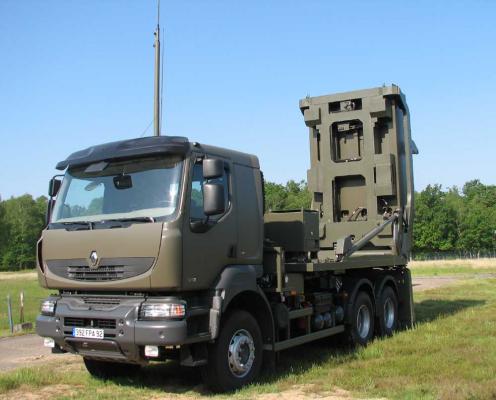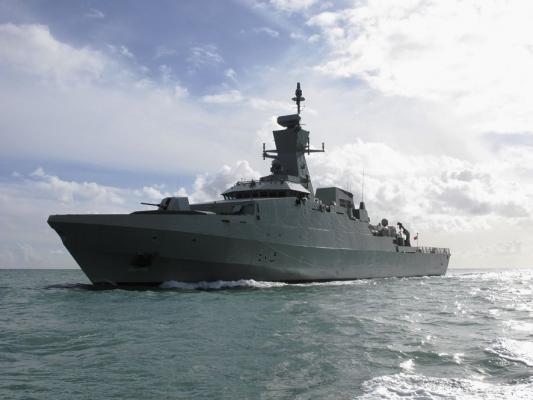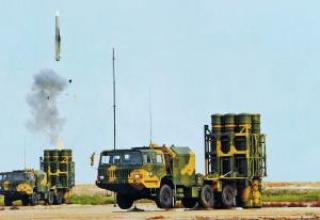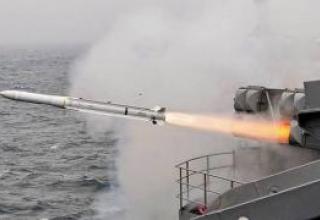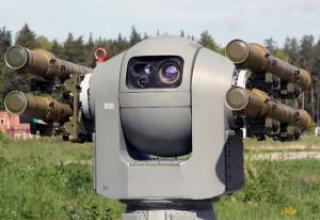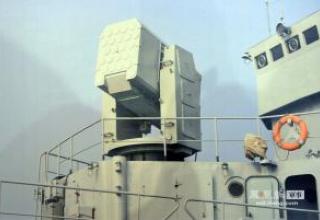The VL MICA (Vertical Launch MICA) anti-aircraft missile system of various designs is used as an anti-aircraft defense tool for units of ground forces, air bases, command posts and surface ships against attacks by cruise missiles, guided air bombs, aircraft, helicopters and unmanned aerial vehicles day and night in all weather conditions. The VL MICA is developed by MBDA on the basis of MICA air-to-air guided missile. The complex is notable for its compactness, high efficiency and its combat capabilities occupy an intermediate position between the Mistral short-range missile and PAAMS long-range missile.
Modular design of the MICA missile allows to have in the ammo a means of destruction with different homing systems and use their advantages depending on the combat situation. The MICA missile can be equipped with an active impulse Doppler homing radar head (MICA-EM) or a thermal imaging head (MICA-IR). The Radar Cruise Launcher provides all-weather capability and is effectively used against enemy assets with low infrared signatures (e.g. guided aircraft bombs). Thermal imaging is preferred when used to engage targets with a small effective scattering surface, including small high-speed surface targets.
The ground version of the complex was first presented in February 2000 at the Asian Aerospace exhibition in Singapore. Testing of the complex started at CELM Test Center (Centre d'Essai de Lancement des Missiles - France) in 2001. In February 2005, the demonstration of the new complex with the use of standard serial MICA-IR missile was successfully carried out, and the target was hit at a range of about 10 km. By January 2006, 11 VL MICA missiles were launched in various configurations.
The works on the ship's air defense system based on the VL MICA vertical launch missile were initiated by MBDA in 2000. The sea version of the VL MICA system is positioned, first of all, as a means of air defense of surface ships of small displacement, for which the weight-size limitations of the deployed weapons are essential, as well as for strengthening the air defense of large ships at short distances. In April 2006 in CELM Test Center VL MICA SAMs were successfully tested from sea-based launchers. During the tests VL Mica directly hit the target simulating a low-flying anti-ship missile at a range of 10 km. During test launches in October 2008, it struck the target (Banshee UAV) directly at a distance of 12 km.
In 2007. The Omani Navy and MBDA entered into an agreement to supply VL MICA SAMs for three ocean patrol vessels (OPV) of the Khareef project (displacement - 2500t, length - 99m). Construction of the first vessel of this project began in October 2007 at VT Shipbuilding's shipyard in Portsmouth. Delivery time to the customer - 2010, the rest - with a six-month interval.
VL MICA is to be installed on the Sigma missile corvettes being built at the Schelde Naval Shipbuilding shipyard in the Netherlands by order of the Moroccan Navy. Delivery of three corvettes of this project is to be completed by 2012. Polish "Gawron" type corvettes pr. 621 (planned series - 7 units) will be presumably armed with two modules for 16 VL MICA missiles, located in the front part of the superstructure. The first ship of the "Slazak" series was laid down in 2001, the delivery date - 2010-2011.
In December 2005 the first ship of the "Slazak" series was built in 2001, the delivery date - 2010-2011. DGA (Delegation Generale pour l'Armement) of the French Ministry of Defence concluded a two-year contract with MBDA for the supply of VL MICA anti-aircraft guided missile for all branches of the armed forces. As part of the contract MBDA performs work on the integration of VL MICA SAMs with the command and control systems of CETAT and MARTHA of the French Air Force and Land Forces.
On July 8, 2009, a MICA-IR missile launched from the ground launcher successfully intercepted a low-flying target at a range of 15 km and 10 m above sea surface at the CELM Test Center. The missile was controlled from a command post located 6 km from the launcher. The purpose of the tests, organized by the MBDA, DGA and the French Air Force, was to demonstrate the prospects of using the VL MICA system for coastal defence purposes. This was the last in a series of 15 successful test launches of VL MICA SAMs.
Composition:
A ground-based VL MICA model air defense system consists of four launchers, a command post and a detection radar. The launchers of the complex can be placed on different cross-country vehicle chassis with carrying capacity of 5 t (see photo).
MICA rocket is made according to the normal aerodynamic scheme and is equipped with a cross-shaped wide chord wing of small elongation. Stabilizer planes with rectangular shape are installed in the nose section of the hull. In the middle part of the missile is a Protac RDTT, equipped with a low smoky blended fuel charge. The engine provides maximum flight speed of VL MICA M=3. The tail part has aerodynamic rudders, engine thrust vector control system unit (SUVT) and data line receiver. SuvT together with the aerodynamic rudders provides maneuvering of the rocket with an overload of 50g at a range of up to 7km and with an overload of 30g at a range of 10km. The combat unit is a 12 kg shrapnel-and-phase directional warhead, the fuse is an active Doppler radar.
MICA EM missile is equipped with an active pulse Doppler GSN AD4A (12-18 GHz), developed by firms "Dassault Electronique" and "GEC-Marconi". The AD4A Pulse-Doppler SOS is capable of independently capturing a target on its trajectory and provides target engagement from any direction, at all angles, day and night, in simple and difficult weather conditions, in conditions of intensive radioelectronic counteraction, against the background of the earth and water surface. The AD4A is placed in the nose section of the missile under a radio-transparent ceramic fairing. The modified version of the AD4A is also used as part of the Aster anti-aircraft missile of SAMP-T and PAAMS systems.
The MICA-IR's 3-5 and 8-12 µm (3-5 and 8-12 µm) bi-spectral thermal imaging homing head (TGHN) is developed by Sagem Defense Segurite. The TGSN contains a sensor matrix installed in the focal plane, an electronic unit for digital signal processing, and an integrated cryogenic system for cooling the matrix of the closed type. Cooling system of TGSN provides autonomous operation of the receiver within 10 hours. High resolution and complex algorithms allow the TGSN to effectively accompany targets at long distances and to disperse heat traps.
The missile is launched vertically with the following inclination towards the target by means of the TGSN. The VL MICA is used in the target acquisition mode after launch and has a maximum range of more than 10 km (up to 20 km for some sources). Prior to target acquisition by the homing head, the missile is controlled by an inertial control system to the primary target designation data transmitted to the missile. The data transmission line is used to transmit correction commands to the missile in the middle section of the trajectory before target acquisition by the homing head. The use of the shot-and-forget principle makes it possible to effectively counteract the saturation of the object's air defense system in the event of massive attacks by enemy aircraft. The firing rate is two seconds. The missiles are launched directly from transport and launch containers (TLCs) that serve for their transportation and storage (see photo). Each container is 3.7 m long and weighs 400 kg in equipment.
To detect air targets and issue target designation, optical-electronic devices, ship-wide detection systems (for the sea version) or any three-axis Giraffe-100 type radar by Ericsson, RAC 3-D by Thales Raytheon Systems and TRML-3D by EADS (for the land version) can be used. The threat assessment (of the enemy's combat vehicle) is carried out by the carrier ship's combat information and control system (BIUS) or by the command post of the complex, which then transmits the results of the target distribution to the interface unit with the missile.
VL MICA in the ground version can be used autonomously or integrated into a single air defense system of an object using fiber optic information exchange lines.
Original VL Seawolf launchers, VL Seawolf vertical launchers and SYLVER (SYSteme de Lancement VERtical) vertical launch system developed by DCNS can be used to place VL MICA SAMs on surface ships. The SYLVER system is designed to launch missiles of various types: anti-aircraft (Mica, VT-1, Aster-15, Aster-30), missile defense (Standard-II Block IV), strike (SCALP Naval, Tactical Tomahawk). Four system sizes are available: A-35, A-43, A-50 and A-70. Modules of 8 A-43 cells or 4 A-35 cells can be used to accommodate VL MICA missiles. Each module has its own venting channel. The deck plate, cell hatches and gas vent hatch are armored, airtight. The A-43 module has a length of 5.4m and weighs 7.5t. Pairing of SAMs VL MICA with BIOS of the carrier ship is carried out through the digital channel of a local network by means of the special electronic block of pairing. On 8 starting cells installation of one interface block and 4 antennas of a data line "ship-rocket" is required.
Characteristics:
| Maximum firing range, km | 10 (20) |
| Maximum flight speed, M | 3 |
| Battle ceilings, m | 9000 |
| The dimensions of the rocket, mm: - length - diameter - wingspan |
3100 160 480 |
| Starter weight, kg | 112 |
| Weight of combat unit, kg | 12 |
| Rate of fire, gunshot/s. | 2 |
Testing:
According to data dated July 2018, the Soviet side sold the rockets and other components of the Hurricane system (it is worth understanding the Hurricane MLRS) to the Syrian side. Some of these rockets were handed over to the Hezbollah movement in the early 2000s.
In 2002, Alyazhedinov Vadim Rashitovich, Skirda Viktor Andreevich was awarded the S.I. Mosin Prize for his work on the topic: "The Hurricane multiple launch rocket system with increased accuracy and heap of fire.
Sergei Sivtsov - designer of control system elements. He made a significant contribution to the development of correcting switchgears for the angular stabilization systems of Smerch and Uragan Rocket Launcher Systems. He took direct part in working out of the given elements, tests and their introduction in a batch production.
Sources:
- International Defence Review, Feb.2005, p. 34, 35
- Jane's Defence Weekly, 11/I 2006, p. 13
- Vertical Launch Mica Short Range Air Defence System
- MBDA demonstrates VL MICA in a coastal defence role
